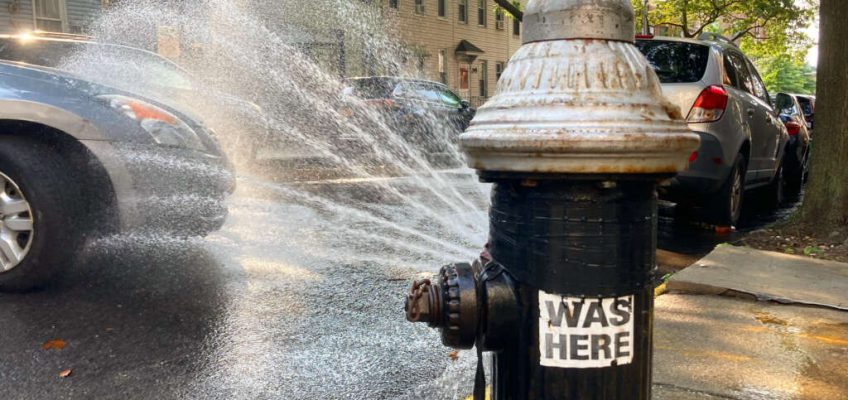“Heat is an infrastructure problem, an economic problem, a policy problem, a community problem, and a health problem. It requires a coordinated approach on all these fronts.”
An open fire hydrant in Brooklyn during a heat wave. (Photo by Jeanmarie Evelly)
New York summers are hot. On average, the city annually weathers 17 days with temperatures above 90 degrees Fahrenheit. But climate change is heating our planet at an alarming rate, making our city’s heat waves hotter, longer, and more frequent.
The New York City Panel on Climate Change projects that in the next 25 years we are likely to experience, on average, between 38 and 62 days above 90 degrees Fahrenheit. By 2080, in the worst-case scenario, we could see as many as 108.
The city’s built environment magnifies hot weather. This phenomenon, known as the urban heat island effect, increases urban temperatures from 3 degrees Fahrenheit up to 20 degrees Fahrenheit higher than suburban and rural settings. The effect is particularly pronounced in densely built areas with limited green space and high concentrations of heat-absorbing surfaces.
But heat exposure is unequal and highly inequitable. According to the city’s Heat Vulnerability Index, low-income communities of color bear disproportionate heat burdens in neighborhoods undermined by historical disinvestment and environmental injustice.
Summer heat is a threat to public health: heat is the leading cause of climate- and weather-related death nationwide. Unlike natural disasters such as floods, heat hazards are invisible, making extreme heat an often underestimated “silent killer.” Around 580 New Yorkers die each summer due to heat-related causes, with Black New Yorkers twice as likely to succumb to heat mortality than white residents.
Heat requires short-term emergency measures to protect residents during heat waves (heat response), and long-term strategies to cool a city (heat mitigation and prevention). In 2021 Miami-Dade County, Florida, officials appointed the world’s first chief heat officer (CHO) and Phoenix, Arizona, opened an office of Heat Response and Mitigation. That same year, officials in Athens, Greece, appointed the first CHO in Europe. Since then, the United Nations and half a dozen cities worldwide have followed suit. It is time for New York City to do the same.
In 2017 the Mayor’s Office of Climate and Environmental Justice (MOCEJ) published the Cool Neighborhoods NYC plan, a coordinating vision for citywide heat response. The plan deserves a “heat czar.” The plan’s mandate encompasses multi-agency programs with several critical responsibilities: coordinating heat mitigation across city agencies, ensuring equitable resource distribution, and integrating heat response into broader climate strategy.
But this plan is not the extent of the city’s heat responses. Our research shows that, in city government, there are currently over 30 specific heat-related programs in 10 departments and agencies under four deputy mayors. This work and the Cool Neighborhoods NYC plan are important, and deserve the greater coordination, dedicated focus, and advocacy of a CHO. It has been eight years since Cool Neighborhoods NYC debuted. It is time to update and turbocharge Cool Neighborhood NYC with a CHO who can align efforts across government, communities, and the private sector.
A CHO would advise and advocate, maintaining focus on the issues of heat and heat resilience. With regulatory and budgetary power, a CHO could accelerate and expand the impact of existing programs. A CHO could coordinate across the city’s full network of existing plans to reduce silos, clarify responsibilities, prevent cross-purpose policies, and streamline financing. A CHO should further advocate for new urban heat mitigation through nature and design, not fossil fuels that add to the climate crisis. A CHO should also advocate for preserving urban spaces for communities; we all need to be able to bear the heat outside.
While NYC recently appointed its first Chief Climate Officer, Rohit T. Aggarwala, his Department of Environment Protection (DEP) is pursuing stormwater and coastal resilience as priorities. According to Aggarwala, “heat and hurricanes” keep him “up at night,” but the DEP has yet to appoint a deputy commissioner dedicated to heat. The City Council also recently failed to pass a bill to codify and improve New York’s cooling center program. Summer is here, and New Yorkers deserve a CHO.
Heat is an infrastructure problem, an economic problem, a policy problem, a community problem, and a health problem. It requires a coordinated approach on all these fronts. Extreme heat will increasingly impact public health but also energy and water use, urban vegetation, transportation, economic productivity, tourism, and workplace safety standards.
New York already has plans and programs in place. The city also has good data and spatial resolution on heat distribution and risk. But without clear management, without sustained advocacy, and without dedicated outreach—in other words, without a CHO—we risk failing to meet the size and scale of the challenge of hotter summers.
Dr. Kara Murphy Schlichting is an associate professor of history at Queens College and the Graduate Center, CUNY, and a co-investigator of the Wellcome Discovery Award project Melting Metropolis: Everyday Histories of Heat and Health in London, New York, and Paris since 1945. Selassie Mawuko is a 2025 Queens College CUNY graduate and former Melting Metropolis research intern.
The post Opinion: It’s Time for NYC to Appoint a Heat Czar appeared first on City Limits.


Leave a Reply